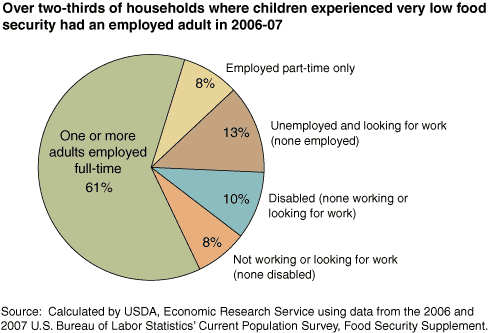Food Insecurity in Households With Children Increased in 2008
- by Alisha Coleman-Jensen and Mark Nord
- 3/1/2010
In 2008, 21 percent of U.S. households with children (8.3 million households) were food insecure, up from 16 percent in 2006 and 2007. Food-insecure households, at times, were unable to acquire adequate food for some household members due to lack of money and other resources for food.
The prevalence of food insecurity in households with children in 2008 was the highest recorded since the Federal Government began monitoring house-hold food security in 1995. Rising food insecurity among these households is of particular concern because good nutrition is important for children’s health and development. Children in food-insecure households are more likely to have poorer physical and mental health, experience more behavioral problems, and exhibit lower academic achievement and fewer academic gains than children in otherwise similar food-secure households.
Very low food security is a severe range of food insecurity in which eating patterns are disrupted and food intake reduced. Most parents in food-insecure households decrease their own food intake to protect children from very low food security. However, in 506,000 households (1.3 percent of households with children), one or more of the children also experienced reduced food intake and disrupted eating patterns in 2008. The prevalence of very low food security among children also increased in 2008, up from 0.8 percent in 2007 and 0.6 percent in 2006.
In 2006-07, one or more adults worked full-time in 61 percent of households with very low food security among children. At least one adult worked part-time in an additional 8 percent of households with very low food security among children, and another 13 percent included an adult who was unemployed and looking for work. No adult had any education beyond high school in 59 percent of households with very low food security among children.
In 2006 and 2007, about 80 percent of food-insecure households with children received assistance from one or more of USDA’s domestic food and nutrition assistance programs, which help families maintain food security during tough economic times and ensure that children get the food they need. Sixty-five percent of food-insecure households with children received free or reduced-price school lunches in 2006 and 2007, 39 percent received SNAP benefits (food stamps), and 24 percent received assistance from the Special Supplemental Nutrition Program for Women, Infants, and Children (WIC).
This article is drawn from:
- Nord, M., Andrews, M. & Carlson, S. (2009). Household Food Security in the United States, 2008. U.S. Department of Agriculture, Economic Research Service. ERR-83.
- Nord, M. (2009). Food Insecurity in Households with Children: Prevalence, Severity, and Household Characteristics. U.S. Department of Agriculture, Economic Research Service. EIB-56.


